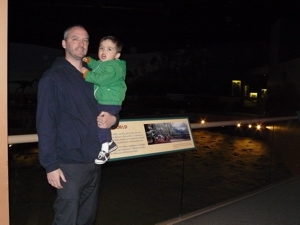NNL 1. Dinosaur Trackway
National Natural Landmark 1
Rocky Hill
Designation Date: 1968
 Of all the nearly 600 National Natural Landmarks, very few are singular items like this. In fact, this one may be the smallest Landmark in the country. I’m guessing it is. The tracks are preserved at Dinosaur State Park and Museum which has a lot more to offer than some 200 million year old dinosaur tracks. Here’s our visit from 2009.
Of all the nearly 600 National Natural Landmarks, very few are singular items like this. In fact, this one may be the smallest Landmark in the country. I’m guessing it is. The tracks are preserved at Dinosaur State Park and Museum which has a lot more to offer than some 200 million year old dinosaur tracks. Here’s our visit from 2009.
From the park’s website:
The Discovery of the Tracks
On August 23, 1966, fossil tracks were uncovered during excavation for a state building. When Edward McCarthy turned over a slab of gray sandstone with his bulldozer, he saw a large footprint with three toes. The news of the discover spread quickly as more tracks were uncovered. Within a few weeks, officials decided to preserve the site as a state park. As a result of careful excavation, the park has one of the largest on-site displays of dinosaur tracks in the entire world.
Why are Names of Tracks and Dinosaurs Different?
Fossil tracks are classified and named independently from fossil animals. Dinosaur State Park’s tracks are named Eubrontes. One
of America’s first geologists, Edward Hitchcock, invented that name and many others in his pioneering studies of Connecticut Valley tracks. No remains of the dinosaur that made Eubrontes have been found in the Valley. However, most scientists agree that the trackmaker was a carnivorous dinosaur similar in size and shape to Dilophosaurus. The tracks range from 10 to 16 inches in length and are spaced 3.5 to 4.5 feet apart. Eubrontes is the official Connecticut State Fossil.
Rock slabs bearing other kinds of Connecticut Valley fossil tracks are displayed in the Exhibit Center. Among them are the large four-toed Otozoum tracks with clearly visible skin impressions.
And there you go.
Back to CTMQ’s NNL, etc page
National Park’s NNL Page
Dinosaur State Park







Leave a Comment